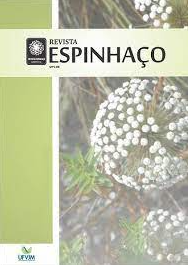Physiographic characterization of two watersheds from the PELD TURF research site in the Chapada do Couto plateau, Southern Espinhaço Range-Brazil
DOI:
https://doi.org/10.5281/zenodo.7858872Keywords:
Hydrology, peatland, hydrologic monitoring, morphometryAbstract
Watersheds are the basic unit for hydrological studies, as they allow the spatial and temporal compartmentalization of water fluxes within the hydrological cycle. The hydrological response of watersheds varies according to numerous factors, such as size and form, drainage network and relief characteristics, among others, what demands the physiographical characterization of watershed in relation to these parameters. The aim of the present study was to characterize two experimental watersheds that are being monitored in the Long-Term Ecological Research Site Peatlands from Southern Espinhaço Mountain Range (PELD TURF) installed in the Chapa do Couto plateau, at the easternmost Southern Espinhaço Mountain Range, Minas Gerais state, Brazil. Both watersheds were characterized according to parameters related to shape and size, parameters related to the drainage network and parameters related to relief. The water discharge from both watersheds was measured on two different years (2021 and 2022) during the dry season (June) and the rainy season (December). The physiographical characterization pointed that the watershed located within the conservation unit of the Rio Preto State Park (RP watershed) was more likely to generate surface runoff, giver its more compact shape, less extensive drainage network and higher slope. Nevertheless, the watershed impacted by anthropization (ARA watershed) presented lower water discharge during the dry season and higher discharges during the rainy season than the RP watershed, possibly indicating that its hydrological response is being affected by the conditions of the recharge area, subject to fires and grazing by cattle.
References
Abreu Filho, A. P., Costa, C.R., Gomes, I.R., Barral, U.M., Viana, A.J.S., Tassinari, D., Vidal-Torrado, P., Silva, A.C. (2021). Os solos e a evolução de paisagens na Serra do Espinhaço Meridional, Brasil. Revista Espinhaço, 10 (1), p. 1-23.
Alaska Satellite Facility Distributed Active Archive Center - ASF DAAC (2015). ALOS PALSAR Radiometric Terrain Corrected High Resolution. ASF Data Search VERTEX.
Barral, U. M. (2018). Hidrologia e fluxo de carbono em turfeiras tropicais de montanha. (Tese de doutorado). Diamantina: UFVJM.
Barral, U. M., Silva, A. C., Christofaro, C., Costa, C. R., Penafort Filho, A., Macedo, G. M., Bispo, D. F. A., Gonçalves, T. S. (2023). Can Anthropization Govern the Water and Carbon Dynamics? A case study of peatlands in Serra do Espinhaço Meridional, Brazil. Wetlands Ecology and Management (no prelo).
Bispo, D.F.A., Silva, A.C., Christofaro, C., Silva, M.L.N., Barbosa, M.S., Silva, B.P.C., Barral, U.M., Fabris, J.D., (2016). Hydrology and carbon dynamics of tropical peatlands from Southeast Brazil. Catena, 143, p. 18–25.
Campos, J.R. R., Silva, A.C., Vidal-Torrado, P. (2012). Mapping, organic matter mass and water volume of a peatland in Serra do Espinhaço Meridional. Revista Brasileira de Ciência do Solo, 36, p. 723–732.
Conrad, O., Bechtel, B., Bock, M., Dietrich, H., Fischer, E., Gerlitz, L., Wehberg, J., Wichmann, V., Böhner, J. (2015). System for Automated Geoscientific Analyses (SAGA) v. 2.1.4. Geoscientific Model Development, 8, p. 1991-2007.
Fraga, L. M. S., Abreu, P. A. A., Neves, S. C. (2005). Hidrologia e Hidrografia. In: Silva, A. C., Pedreira, L. C. V. S. F., Abreu, P. A. A. (eds.) Serra do Espinhaço Meridional: paisagens e ambientes. Belo Horizonte: O Lutador. p. 79-94.
Mello, C. R., Silva, A. M., Beskow, S. (2020). Hidrologia de Superfície: princípios e aplicações. 2ª ed. Lavras: Editora UFLA. 531 p.
Neves, S. C., Abreu, P. A. A., Fraga, L. M. S. (2005). Hidrologia e Hidrografia. In: Silva, A. C., Pedreira, L. C. V. S. F., Abreu, P. A. A. (eds.) Serra do Espinhaço Meridional: paisagens e ambientes. Belo Horizonte: O Lutador. p. 45-58.
QGIS Development Team (2023). QGIS Geographic Information System: version 3.28.3 Firenze. Open Source Geospatial Foundation Project.
Santos, I. Fill, H. D., Sugai, M. R. B., Buba, H., Kishi, R. T., Morone, E., Lautert, L. F. C. (2001). Hidrometria Aplicada. Curitiba: ITEC. 373 p.
Silva, A. C., Christofaro, C., Barral, U. M., Tassinari, D. (2022). Serviços ecossistêmicos. In: Silva, A. C., Rech, A. R., Tassinari, D. (orgs.). Turfeiras da Serra do Espinhaço Meridional: serviços ecossistêmicos, interações bióticas e paleoambientes. Curitiba: Appris. p. 49-80.
Silveira, A. L. L. (2005). Desempenho de Fórmulas de Tempo de Concentração em Bacias Urbanas e Rurais. Revista Brasileira de Recursos Hídricos, (10) 1, p 5-23.
Souza, M. A. T. A., Grossi-Sad, J. H. 1997. Geologia da folha Rio Vermelho. In: Grossi-Sad, J. H., Lobato, L. M., Pedrosa-Soares, A. C., Soares-Filho, B. S. (coord.). Projeto Espinhaço Em CD-ROM (textos, mapas e anexos). Belo Horizonte: COMIG - Companhia Mineradora de Minas Gerais. p. 1667-1806.
Ward, A. D., Trinble, S. W., Burckhard, S. R., Lyon, J. G. (2016). Environmental Hydrology. 3rd ed. Boca Raton: CRC Press. 651 p.
Downloads
Published
How to Cite
Issue
Section
License
Copyright (c) 2023 Revista Espinhaço

This work is licensed under a Creative Commons Attribution-NonCommercial-NoDerivatives 4.0 International License.


